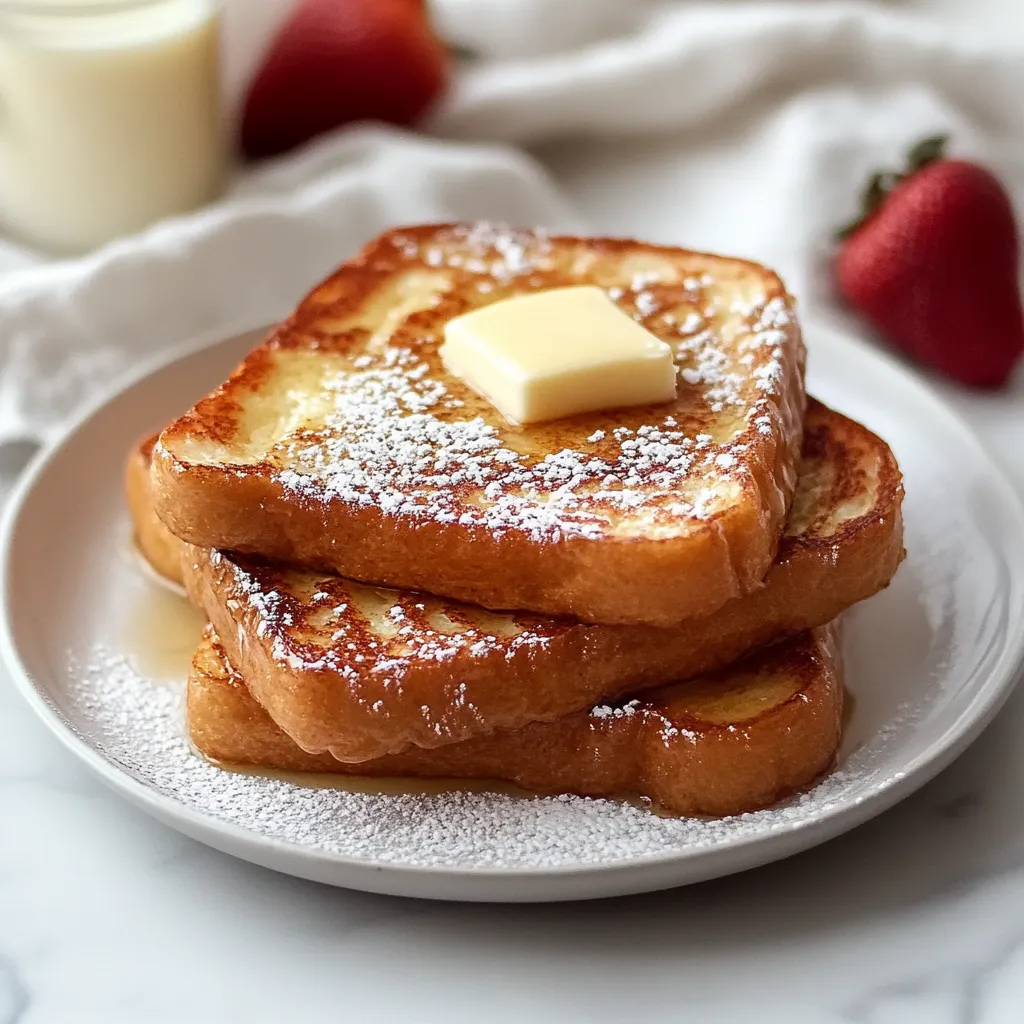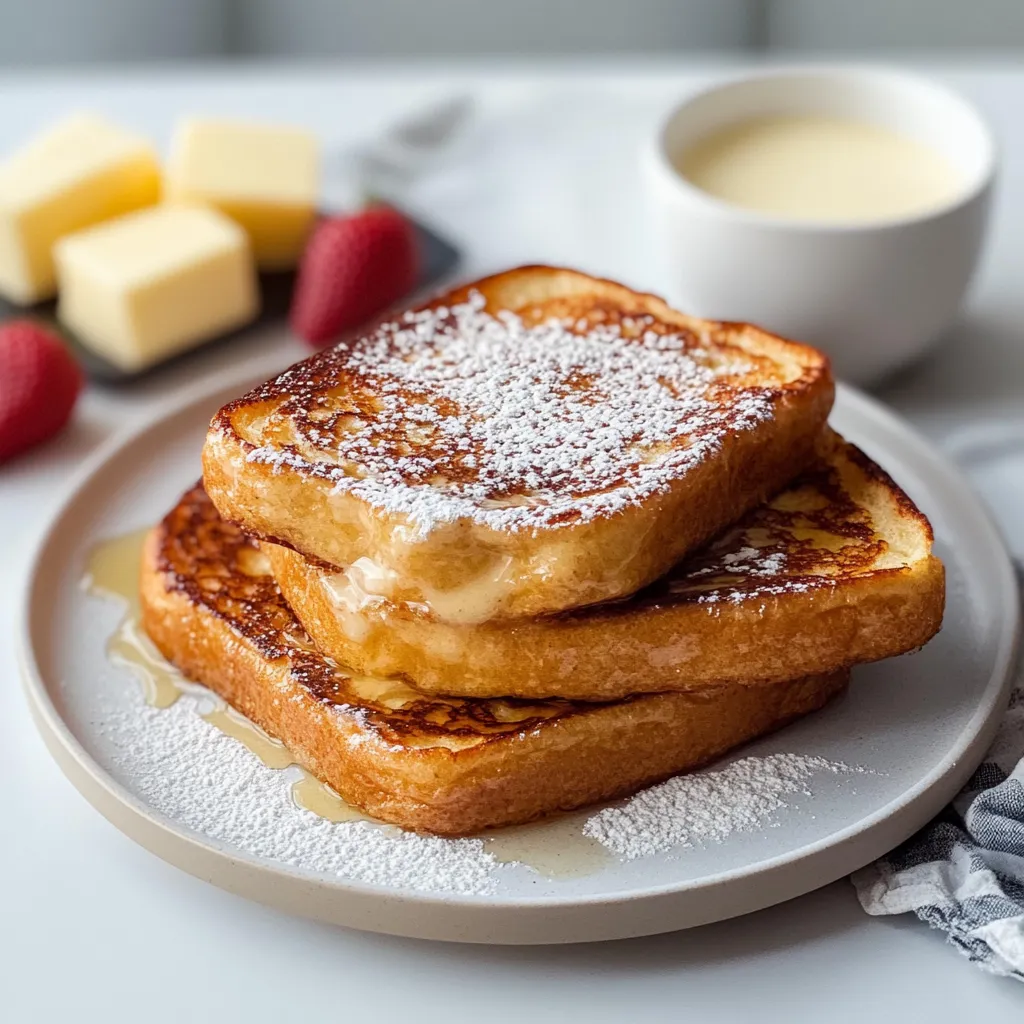 Bookmark
Bookmark
This classic French toast recipe transforms ordinary bread into a decadent breakfast treat that feels like dessert for breakfast. The rich custard creates a velvety interior while the butter-crisped exterior gives that perfect contrast in textures. It's become my weekend tradition when I want to make breakfast feel special without spending hours in the kitchen.
I first made this French toast for a holiday brunch when I had overnight guests. The way their eyes lit up when they took their first bite convinced me this recipe needed to be in my permanent rotation. Now it's our Sunday morning tradition.
Ingredients
- Challah or Brioche Bread thick slices are essential for creating that perfect custardy center while maintaining structure
- Half-n-Half or Heavy Cream provides richness that milk alone cannot achieve
- Eggs create the custard base and help develop that golden exterior
- Sugar balances the flavors and helps with caramelization
- Vanilla Extract adds depth and warmth to the custard mixture
- Cinnamon brings a subtle spice that complements the richness
- Salted Butter for cooking creates that irresistible golden crust and adds flavor
Step-by-Step Instructions
- Prepare the Bread
- Slice your challah or brioche into thick slices approximately 1-inch thick. Day-old or slightly stale bread works best as it has less moisture and can absorb more custard without falling apart. If you only have fresh bread, you can toast it lightly in a 250°F oven for about 5 minutes to dry it slightly.
- Mix the Custard
- Whisk together the cream or half-n-half, eggs, sugar, vanilla extract, and cinnamon until thoroughly combined. For the smoothest texture, consider using an immersion blender or regular blender to fully incorporate the cinnamon into the mixture. The custard should be a uniform pale yellow color with visible specks of cinnamon throughout.
- Soak the Bread
- Dip each slice of bread into the custard mixture, allowing it to soak for approximately 20 seconds per side. The bread should absorb the custard but still maintain its structure. Hold the slice above the bowl briefly to allow excess custard to drip off. Place soaked slices on a plate while preparing your cooking surface.
- Prepare the Cooking Surface
- Heat a large skillet or griddle over medium-low heat. Add a generous tablespoon of butter and allow it to melt completely, swirling to coat the surface. The butter should foam slightly but not brown.
- Cook to Perfection
- Place 2-3 slices of soaked bread onto the buttered surface, being careful not to overcrowd. Cook for 3-5 minutes on the first side until golden brown. Flip carefully with a wide spatula and cook an additional 3-5 minutes on the second side. The exterior should be golden and slightly crisp, while the interior remains custardy and fully cooked.
- Serve Immediately
- Transfer to warm plates and serve right away with a dusting of powdered sugar, a pat of salted butter, and warm maple syrup. For an extra special touch, add fresh berries or sliced bananas.
 Bookmark
Bookmark
I discovered the importance of quality vanilla extract in this recipe after splurging on Madagascar bourbon vanilla. The difference was remarkable, transforming an already delicious breakfast into something truly memorable. My daughter now insists we use the good vanilla for our Sunday French toast sessions.
The Secret to Perfect Soaking
The most common mistake with French toast is insufficient soaking time. Many recipes suggest a quick dip, but allowing the bread to truly absorb the custard creates that magical texture contrast. Think of it like making bread pudding, where the bread needs to become one with the custard. However, be careful with very soft bread varieties as they can become too soggy if soaked too long.
Make It Your Own
This recipe serves as a perfect base for countless variations. Try adding orange zest to the custard for a citrusy twist, or a splash of bourbon for an adult version. You can also experiment with different bread varieties like cinnamon-raisin bread, sourdough for a tangier profile, or even banana bread for an ultra-decadent treat. The custard recipe remains the same, allowing for endless creativity.
Troubleshooting Common Issues
If your French toast is browning too quickly on the outside while remaining uncooked inside, your heat is too high. The secret is cooking low and slow to allow the custard to set throughout before the exterior becomes too dark. Another common issue is soggy French toast, which usually happens when the bread is too fresh or when excess custard isnt allowed to drip off before cooking. Remember that patience is key for perfect French toast.
Recipe FAQs
- → Why should I use stale bread for French toast?
Stale, day-old bread is sturdier and has less moisture, allowing it to better absorb the custard mixture without falling apart during soaking or cooking. Fresh bread tends to become too soggy and may break when handled.
- → What's the best cooking temperature for French toast?
Cook French toast on medium-low to low heat. This slower cooking method ensures the egg-custard mixture in the center cooks through completely while allowing the exterior to develop a perfect golden-brown color without burning.
- → Can I make the custard mixture ahead of time?
Yes, you can prepare the custard mixture (cream, eggs, sugar, vanilla, and cinnamon) up to 24 hours in advance. Store it covered in the refrigerator, then whisk again before using to ensure ingredients are well combined.
- → Why isn't my cinnamon incorporating well into the custard?
Cinnamon can be difficult to incorporate evenly. For best results, use an immersion blender or regular blender to fully integrate the cinnamon into the custard mixture, preventing clumping and ensuring consistent flavor throughout.
- → How long should I soak the bread in the custard?
Soak each slice for about 20 seconds per side. The bread should absorb enough custard to flavor the interior but not so much that it becomes soggy and falls apart. Allow excess custard to drain off before cooking.
- → What's the difference between using half-and-half versus heavy cream?
Heavy cream will produce a richer, more decadent French toast with a creamier interior texture. Half-and-half creates a slightly lighter version while still maintaining good flavor and texture. Both work well, with the choice depending on your preference for richness.
